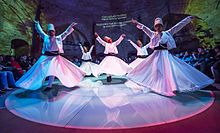Mevlevi
 |
|
| Abbreviation | Mevlevi |
|---|---|
| Formation | 1312 |
| Type | Dervish Order |
| Headquarters | Konya, Turkey |
|
Makam Chalabi (Chief Master)
|
Faruk Hemdem |
|
Key people
|
Shams Tabrizi – Patron Saint Rumi - Patron Saint Sultan Veled - Founder |
| Website | [1] |
| Mevlevi Sema Ceremony | |
|---|---|

Hodjapasha Culture Center is a beautifully restored Ottoman hamam (Turkish bath) in Istanbul's Sirkeci district now used for performances of the Mevlevi (whirling dervish) sema. Istanbul
|
|
| Country | Turkey |
| Reference | 100 |
| Region | Europe and North America |
| Inscription history | |
| Inscription | 2008 (3rd session) |
The Mawlaw'īyya / Mevlevi Order (Turkish: Mevlevilik or Mevleviyye Persian: طریقت مولویه) is a Sufi order in Konya (capital of the Anatolian Seljuk Sultanate) founded by the followers of Jalal al-Din Muhammad Balkhi-Rumi, a 13th-century Persian poet, Islamic theologian and Sufi mystic. The Mevlevi are also known as the Whirling Dervishes due to their famous practice of whirling as a form of dhikr (remembrance of God). Dervish is a common term for an initiate of the Sufi path; the whirling is part of the formal Sama ceremony and the participants are properly known as semazen-s.
In 2008, UNESCO confirmed the "The Mevlevi Sema Ceremony" of Turkey as amongst the Masterpieces of the Oral and Intangible Heritage of Humanity.
The Mevlevi order was founded in 1273 by Rumi's followers after his death, particularly by his successor Hüsamettin Çelebi who decided to build a mausoleum for their master, and then their master's son, Baha al-Din Muhammad-i Walad (or Çelebi, Chelebi, meaning "fully initiated"). He was an accomplished Sufi mystic with great organizing talents. His personal efforts were continued by his successor Ulu Arif Çelebi.
The Mevlevi believe in performing their dhikr in the form of a "dance" and musical ceremony known as the Sama, which involves the whirling, from which the order acquired its nickname. The Sama represents a mystical journey of man's spiritual ascent through mind and love to the "Perfect". Turning towards the truth, the follower grows through love, deserts his ego, finds the truth, and arrives at the "Perfect". He then returns from this spiritual journey as a man who has reached maturity and a greater perfection, able to love and to be of service to the whole of creation.
...
Wikipedia
